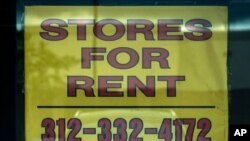Claims for jobless benefits jumped in the U.S. last week, the Labor Department reported Thursday, as the world’s biggest economy remains on an uneven recovery from the coronavirus pandemic.
A total of 419,000 unemployed workers sought government compensation, up 51,000 from the revised figure of the week before, the agency said. The new figure followed declines in the number of claims in recent weeks and remained well above the 256,000 total recorded just before the coronavirus waylaid the American economy 16 months ago and closed many U.S. businesses.
The weekly claims total has tracked unevenly in recent weeks, but overall, jobless claims, a proxy for layoffs of workers, have fallen by more than 40% since early April, while remaining well above the pre-pandemic levels.
About 9.5 million people remain unemployed in the U.S. and looking for work. There also are 9.2 million job openings, the government says, although the skill sets of the jobless do not necessarily match the needs of employers.
The U.S. added 850,000 jobs in June, with the unemployment rate at 5.9%. Some employers are offering new hires cash bonuses to take jobs as the economy rebounds and consumers are willing to spend.
State governors and municipal officials across the U.S. have been ending coronavirus restrictions, in many cases allowing businesses for the first time in a year to completely reopen to customers. That could lead to more hiring of workers.
Nearly 60% of U.S. adults have now been fully vaccinated against the coronavirus, boosting the economic recovery, although the pace of inoculations has dropped markedly from its peak several weeks ago, worrying health experts and government officials.
Now, the Delta variant of the coronavirus is spreading rapidly, infecting tens of thousands of people who have not been vaccinated.
Officials in many states are offering a variety of incentives to entice the unvaccinated to get inoculated, including entry into lucrative lotteries for cash and free college tuition. The U.S. did not meet President Joe Biden’s goal of 70% of adult Americans with at least one vaccination shot by the July 4 Independence Day holiday. The figure stands shy of that at 68.4%, with Biden and health officials often calling for more people to get vaccinated.
With the business reopenings, many employers are reporting a shortage of workers, particularly for low-wage jobs such as restaurant servers and retail clerks. Biden suggested Wednesday night at a CNN town hall with voters in Ohio that employers having trouble finding enough workers may simply need to offer would-be workers more money to get them to agree to accept a job opening.
The federal government approved sending $300-a-week supplemental unemployment benefits to jobless workers through early September on top of less generous state-by-state payments.
But at least 25 of the 50 states, all led by Republican governors, are ending participation in the federal payments program, contending that the stipends let workers make more money than they would by returning to work and thus are hurting the recovery by not filling available job openings.
Some economists say, however, other factors prevent people from returning to work, such as lack of childcare or fear of contracting the coronavirus as the Delta variant first found in India infects more people.
The economic picture in the U.S. has advanced as money from Biden’s $1.9 trillion coronavirus relief package filters through the economy. The measure has likely boosted consumer spending, as millions of Americans, all but the highest wage earners, are now receiving $1,400 stimulus checks from the government or have already been sent the extra cash.
With more money in their wallets and more people vaccinated, Americans are venturing back to some sense of normalcy, going out to restaurants and spending money on items they had not purchased for a year.
Biden is supporting a plan to spend $1.2 trillion to repair deteriorating roads and bridges and construct new broadband service, agreeing to the deal with a group of centrist lawmakers. But lawmakers have struggled to reach a deal on how to pay for the package. With its approval still possible, it could add thousands of construction jobs to the U.S. economy.
Last week, Democratic lawmakers unveiled a $3.5 trillion plan for more health care coverage for older Americans, increased financial benefits for most U.S. families with young children, and more spending to advance clean energy. But Republicans are uniformly opposed to its cost and Biden’s plan to pay for it with higher taxes on corporations and the wealthiest Americans.
The so-called human infrastructure measure will only win passage in the Senate if Democrats vote as a unified 50-member bloc, with Vice President Kamala Harris casting the deciding tie-breaking vote in the politically divided Senate, because no Republicans currently support it.











